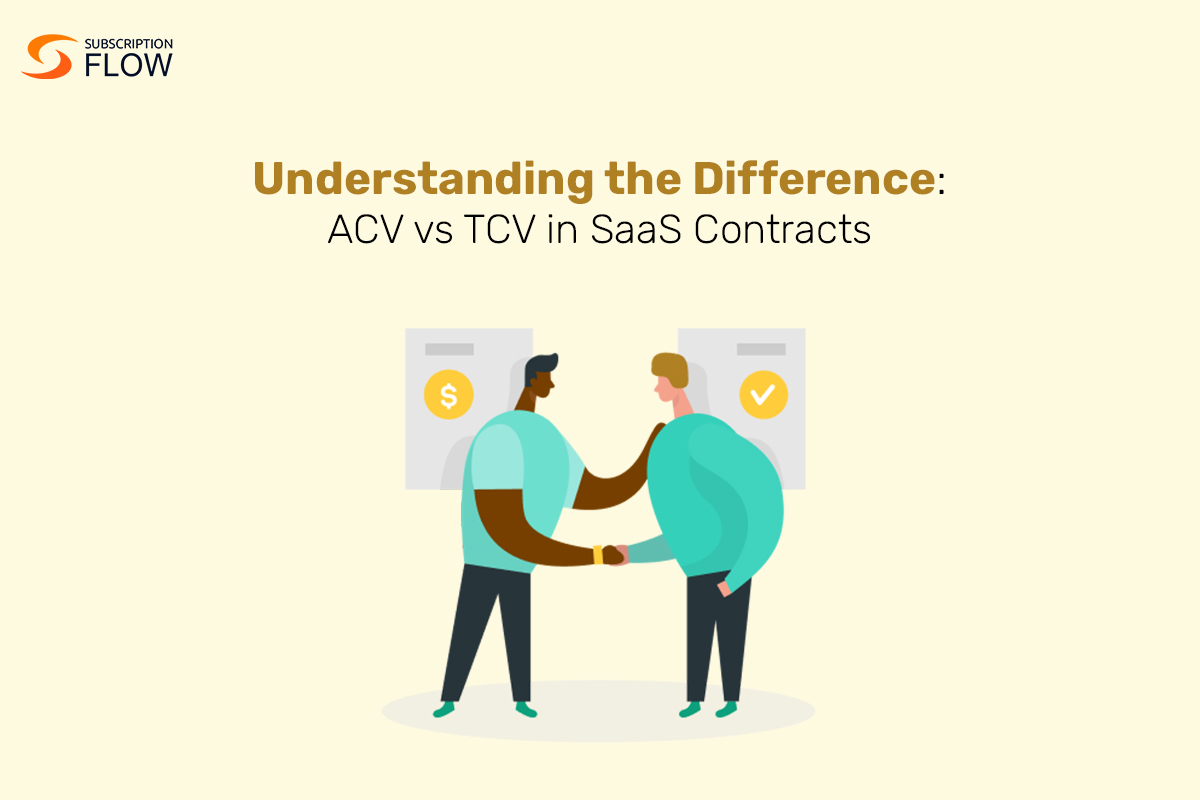
Understanding the Difference: ACV vs TCV in SaaS Contracts
SaaS businesses use terms like ACV and TCV to index their financial health and create predictions for informed decision making. It is very easy though to conflate all these terms—ACV and TCV are just the tip of the iceberg, the SaaS industry also uses metrics like LTV and ARR amongst many others.
For clarity’s sake then, this blog will explain the difference between ACV vs TCV, defining both terms and discussing their impact on the SaaS world.
What is ACV?
ACV stands for Annual Contract Value. It’s a key performance indicator measuring the average value of a 12-month contract. Basically, it provides an overview of the revenue your business generated from a single contract or customer over a year’s time.
ACV counts all charges that occur in the timespan of a year including: recurring, one-off, usage-based, etc. ACV doesn’t usually include initial charges, one-time setup or implementation fees. These calculations normalize contract amounts, helping compare customers whose contracts differ in duration or type.
What is TCV?
TCV stands for Total Contract Value. This metric calculates the total revenue generated by your business for a SaaS subscription contract or customer over the length of a term. TCV measures one-off payments, recurring revenue, overuse charges, etc. Implementation fees associated with a contract are also included in TCV calculations.
Essentially, TCV takes into consideration the total sum of payments your business receives against a contract, regardless of whether that revenue is acknowledged over time or upfront.
ACV vs TCV: Calculations
1. How to Calculate ACV
Calculating ACV is relatively straightforward. The following formula can be used:
ACV = Total Contract Value (TCV) / Contract Term (in years)
To illustrate this, let’s say you’re selling a customer relationship management (CRM) SaaS tool.
You sign a two-year SaaS contract with a client detailing a $8000 setup fee to import their data, customize the platform to their needs, train their team members, plus a $1000 monthly flat fee to access the platform.
This contract is set to generate $32,000 (TCV) during its entire span. The ACV for this contract is $16,000 per year.
2. How to Calculate TCV
The formula for calculating TCV is simple:
TCV = Annual Contract Value (ACV) x Contract Term (in years)
To illustrate this, if a customer signs a three-year contract with an ACV of $10,000 per year, the TCV for that contract is $30,000.
Any change in the length of the contract can affect the final TCV calculation.
ACV vs TCV Comparison: Key Differences
Now that we understand what ACV and TCV refer to, let’s explore the fundamental differences between these two key SaaS metrics:
1. Scope of Measurement
ACV focuses on the annual revenue generated from a single contract whereas TCV considers the total revenue generated over the entire contract term. This naturally means that they tell you about different revenue generation timelines for your SaaS business.
You may want to look at a macro perspective and check the total contract values in a financial quarter or over multiple years. ACV is a good way to look at the year-on-year growth of the contract value for revenue forecasting and planning.
2. Timeframe
Since ACV calculations occur over a 12-month period, it’s ideal for assessing revenue performance short-term. On the other hand, for evaluating long-term performance, TCV is the better option as it shows a contract’s cumulative value over the entirety of its term.
3. Use Cases
As ACV is a short-term performance metric, it’s used most often for sales and marketing queries to evaluate the immediate impact of contracts on revenue. Meanwhile, TCV is useful for finance and accounting teams as it helps guide long-term financial planning by presenting the total revenue commitment.
4. Nuance
ACV gives more nuanced insights as it analyzes revenue over a year’s time frame. TCV, on the other hand, presents a broader, bird’s-eye view of the contract’s value.
ACV vs TCV: When to Use Each One
Choosing when to use ACV vs TCV depends on the specific goals you’ve set for your business as well as on the kinds of insights you seek. As we’ve discussed so far, each metric has its own particular uses and is most suited to situations that best utilize its specifications.
Choose ACV when:
- Assessing the short-term impact of contracts. With this granular approach you can gain insight on your year-on-year revenue growth.
- Optimizing pricing strategies for annual subscriptions. Data on your yearly revenue generation performance can assist you in revising your pricing strategy to maximize profits.
- Analyzing the performance of sales and marketing efforts on an annual basis. Given its annual nature, it helps give you a neat look on how much revenue was generated yearly, similar to ARR (annual recurring revenue) for a year of sales activity.
- Identifying which individual customer accounts hold the greatest revenue potential.
Choose TCV when:
- Assessing your SaaS business’s long-term financial health. TCV gives a high-level overview to better understand your company’s revenue performance.
- Strategizing in regard to resource allocation, scaling, and expansion decisions. Since TCV provides a macroscopic view of revenue performance it’s useful for developing growth strategies for future use.
- Showing stakeholders and investors financial results for the entire contract term.
- Using a financial lens to analyze your client base’s structure. High TCV values help identity revenue leaders amongst the customer base so that you can focus your marketing efforts on them for increased revenue generation.
Conclusion
ACV and TCV are important metrics for calculating revenue in the SaaS industry. They each offer their own unique insights into your subscription contracts as per your business’s needs. ACV provides a more nuanced view of individual contracts, focusing more on annual revenue. TCV, meanwhile, gives a broader overview of the total contract value over time. It is important to understand the difference between these two metrics for informed decision making regarding resource allocation, pricing, and long-term growth strategies. For SaaS business owners, effectively utilizing ACV and TCV metrics can help them navigate the SaaS industry more easily, setting them on the path to sustainable growth and profitability. Book a demo with SubscriptionFlow now and begin your journey with this SaaS subscription management tool!









